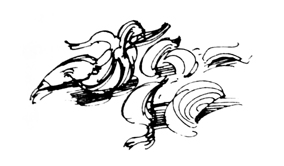Beard on Birds James Beard Introduction by Julia Child  CHAPTER 1ChickenChicken ClassificationsSQUAB CHICKENThe youngest of chickens on the market, weighing about a pound, and usually broiled, either split or whole. You will need one per serving. Expensive and hard to find.CORNISH GAME HENYoung hens, weighing 1 to 1 pounds. You will need one per serving of the smaller birds. Use for roasting, sauting, or broiling.BROILERSThese are young birds, weighing 1 to 2 pounds, and extremely tender. They should be firmly meated, with a little fat on them.
CHAPTER 1ChickenChicken ClassificationsSQUAB CHICKENThe youngest of chickens on the market, weighing about a pound, and usually broiled, either split or whole. You will need one per serving. Expensive and hard to find.CORNISH GAME HENYoung hens, weighing 1 to 1 pounds. You will need one per serving of the smaller birds. Use for roasting, sauting, or broiling.BROILERSThese are young birds, weighing 1 to 2 pounds, and extremely tender. They should be firmly meated, with a little fat on them.
Use for broiling and some sauting. Sometimes cooked whole, they are generally split in half. In this case, remove the back and neck with poultry shears and press down firmly to flatten the two halves and allow more even cooking. One half-broiler is considered a portion.FRYERS OR BROILER-FRYERSThese all-purpose birds weigh between 2 and 3 pounds. They are cooked either split, as is the case with broilers, or cut into smaller serving portions and broiled, sauted, fried, or braised. Be sure to cutdo not chopthe chicken.
Slice between the legs and body through the thigh joint. Cut each leg and thigh in half at the joint. Then cut through the wing joints. Next split the carcass, using poultry shears. The breast can be boned out or left intact and cut into two pieces; or, in the case of a large and meaty chicken, cut into three pieces. (Always include these for people who love to pick bones. (Always include these for people who love to pick bones.
I am one.) Thus, you can get as many as twelve pieces from one bird.ROASTERSLarger birds ranging from 4 to 6 pounds. They may be used for poaching as well as roasting.CAPONSCapons are unsexed male birds whose flesh is tender and delicate. These weigh up to 8 or 9 pounds and should be considered if you are serving more than four people. They are no longer hormone fed, due to government regulations, so you should feel quite safe in using them. More expensive than other chickens.FOWLA mature or old hen, used for poaching or for fricassees, and wonderful eating if you can find one. Ranging in weight from 4 to 8 pounds, they are usually well-retired layers.
However, they are seldom found in markets nowadays, and the fowl that does appear is, in my opinion, only worthy of being used to make strong broth. Beware of something called a roasting fowl; it will never tenderize by roasting.Sauted ChickenChicken is sauted as often as it is fried, although people tend to confuse the two terms. The difference lies in the amount of fat used. A small amount is used for sauting; in frying, the food is well steeped in fat or entirely covered with it.Buy broilers or small fryers for a saut. Tiny chickens can be sauted whole. Larger chickens should be cut in half or in convenient serving pieces.
And be sure the giblets are included, for they make a saut even better.The prime utensil to use for this form of cookery is an iron skillet or saut pan, although any heavy pancast aluminum, stainless steel, or enamel on ironcan be used. The pan should be equipped with a lid that fits tightly.Any choice of fats can be used. Clarified butter is the finest, followed by olive oil, peanut oil, and corn oil; margarine gives acceptable results, too; and bacon fat is wonderful, although it brings another flavor into your dish.To saut, heat a light film of butter or other fat in the pan. Depending on the amount of chicken being prepared, you will generally need 2 to 5 tablespoons. Brown the chicken on all sides over a brisk flame, then cover and let tenderize over low heat. If you are making a sauce for the dish, remove the pieces of chicken to a hot platter while you prepare it.
To rewarm, either return the chicken to the pan and heat with the sauce for a few moments, or keep the chicken warm on a hot platter and pour the sauce over it. BASIC CHICKEN SAUT2 broilers or fryers, 2 pounds each6 tablespoons butterFlour for dredging (optional)Salt and freshly ground black peppercup dry white wine3 to 4 tablespoons chopped parsleyEach chicken should be cut into four piecestwo breast halves with the wings attached, and the two legs and thighs with part of the backbone. Wipe the chicken with a damp cloth if you wish.Sauts should not be overcrowded in the pan. Therefore, since you are preparing two chickens, it might be wise to use two pans, putting the white meat in one and the dark meat in the other, since they require different cooking times.Melt the butter in one very large heavy skillet or two smaller ones with a tight-fitting lid or lids. Add the chicken pieces and brown them over medium-high heat on all sides. (For a deeper color, flour the chicken first.) Season to taste with salt and pepper, then reduce the heat, cover, and cook very gently for about 5 to 10 minutes. Remove the cover or covers and rearrange the pieces so they will cook evenly.
BASIC CHICKEN SAUT2 broilers or fryers, 2 pounds each6 tablespoons butterFlour for dredging (optional)Salt and freshly ground black peppercup dry white wine3 to 4 tablespoons chopped parsleyEach chicken should be cut into four piecestwo breast halves with the wings attached, and the two legs and thighs with part of the backbone. Wipe the chicken with a damp cloth if you wish.Sauts should not be overcrowded in the pan. Therefore, since you are preparing two chickens, it might be wise to use two pans, putting the white meat in one and the dark meat in the other, since they require different cooking times.Melt the butter in one very large heavy skillet or two smaller ones with a tight-fitting lid or lids. Add the chicken pieces and brown them over medium-high heat on all sides. (For a deeper color, flour the chicken first.) Season to taste with salt and pepper, then reduce the heat, cover, and cook very gently for about 5 to 10 minutes. Remove the cover or covers and rearrange the pieces so they will cook evenly.
Add cup wine, recover, and cook 10 minutes more. Uncover and move the pieces of white meat to the top (if using one skillet), leaving the dark meat, which takes longer to cook, on the bottom. Cover and cook until the chicken is just tender and done, but still juicy, about 5 to 10 minutes more.Remove the chicken pieces to a hot platter. Add the remaining wine and the parsley to the pan or pans, turn up the heat, and boil, scraping up the brown glaze from the bottom with a wooden spoon. When the juices have reduced a little, pour over the chicken.Serves four.A SAUT WITH WHITE WINE AND HERBS2 broilers or fryers, 2 pounds each, quartered6 tablespoons butter or butter and oil1 medium onion, finely choppedSalt and freshly ground black pepper1 tablespoon each chopped fresh parsley, chives, chervil, and tarragon (or substitute 1 teaspoon dried herbs where necessary)cup dry white wineLemon juice to tasteBrown the chicken pieces in the butter in one very large skillet or two smaller ones. Add the finely chopped onion, reduce the heat, and cover.
Cook for about 10 minutes. Rearrange the pieces to cook evenly, and cook until tender, about 10 minutes more. Season to taste with salt and pepper, and add the herbs. Pour the wine over the chicken, cover, and let it cook down with the herbs, onion, and chicken juices. Degrease the sauce and correct the seasoning. Just before serving, add a few drops of freshly squeezed lemon juice.
Next page















